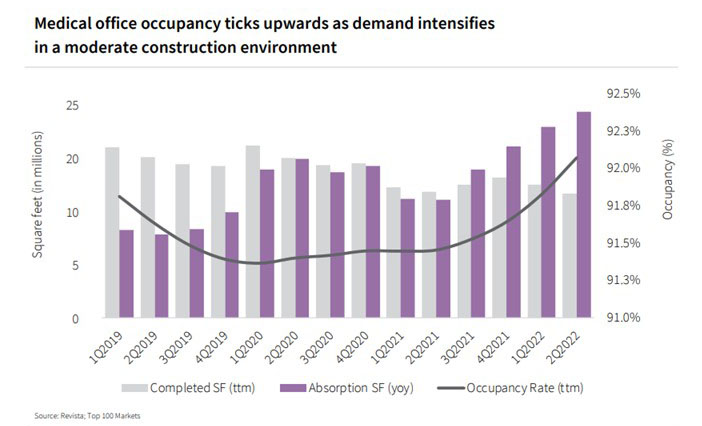
Outpatient Healthcare Facilities Set for Strong Growth

(Proposed Inova Alexandria Hospital at Landmark in Virginia, scheduled to open in 2028. Artist rendering courtesy Inova.)
The aging U.S. population is driving demand for outpatient healthcare services facilities, which reinforces stability of medical office assets, reported JLL, Chicago.
People over 55 comprise just 30% of the U.S. population but consume most healthcare services, and the 80+ cohort could balloon by nearly 50% in the next 10 years, JLL said in its Healthcare and Medical Office Perspective report. Growth of the elder population, longer life expectancies and better healthcare delivery all fuel demand for outpatient healthcare services and facilities, reinforcing medical office as one of the most stable real estate asset classes.

“If we consider that the older population will potentially grow from 46 million residents in 2020 to 80 million in 2050, we can anticipate that the demand for healthcare services and facilities will grow steadily and significantly,” said Jay Johnson, U.S. Practice Leader for Healthcare Markets with JLL. “We expect the elder population to drive significant outpatient demand over the next 10 years, which, in turn, is a fundamental driver for healthcare-related real estate despite the potential offsetting effects of telehealth and home care.”
Outpatient services typically include any service, procedure or treatment that doesn’t require hospital admittance, including x-rays, minor surgeries, bloodwork, routine visits in a medical office setting with a healthcare provider, counseling services and more.
JLL said outpatient sites dominate healthcare services delivery compared to hospital admissions. Additionally, up to a third of hospital revenue is activity shifting to ambulatory surgery centers, office-based labs and other ambulatory sites, while inpatient discharges continue to decline due to regulatory changes, competition among healthcare systems in high-growth markets and technological innovation fueling a shift to outpatient settings.
“More sophisticated procedures can be done in outpatient settings than possible a decade ago,” added Amber Schiada, Head of Americas Work Dynamics and Industry Research with JLL. “Innovation in care combined with reimbursement pressures are driving a sustained shift to outpatient facilities, and consumer preferences for outpatient care have increased as well, as outpatient facilities are often more accessible or conveniently located. Furthermore, experience shows that outpatient locations are less expensive to build and operate.”
Medical offices and clinics are expected to receive the biggest share of growth, JLL said. “Hospital outpatient, ambulatory surgery, laboratory services, physical therapy, emergency medicine and oncology centers will all benefit from outpatient growth,” noted Alison Flynn Gaffney, JLL Healthcare Division President. “Reimbursement policies will continue to support this shift, and specialized care options will further drive competition within the industry.”
JLL identified Austin, Phoenix, Raleigh, Las Vegas and Jacksonville, Fla., as the top five growth markets based on anticipated outpatient volume between 2020 and 2025 and outpatient growth. “This is consistent with the trend of the U.S. aging population migrating to Sun Belt markets. Austin, Raleigh, Dallas, Las Vegas, and Atlanta are the top five growth markets for those ages 55 and up,” the report said.
